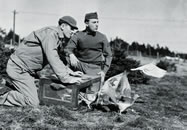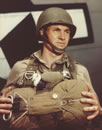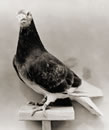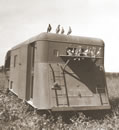In fierce fighting and deep in enemy territory, American pigeons carried life-or-death messages that radio and field phones could not.
By Joe Razes
 The company of Nepali Gurkhas and the British troops with them were trapped on Hangman’s Hill. They had fought their way onto the huge outcropping on Monte Cassino, southeast of Rome, during the fierce battle there in early 1944, only to be pinned down by withering German fire. Stuck for nine days, they had no means of communication with their lines below. American bombers dropped food and water to them, but much of it fell into German hands. Finally, three British volunteers set out toward the trapped men by three different routes. Each carried a haversack with an American homing pigeon inside. One man got pinned down by machine gun spray, but the other two penetrated German lines and reached their destination. All three men scribbled short messages about the routes they had taken and sent them off to headquarters by pigeon. That night, Allied guns opened fire to clear an escape route along the safe paths the scouts had identified, and the trapped soldiers slipped away to safety. The pigeons, meanwhile, rested safely in their loft.
The company of Nepali Gurkhas and the British troops with them were trapped on Hangman’s Hill. They had fought their way onto the huge outcropping on Monte Cassino, southeast of Rome, during the fierce battle there in early 1944, only to be pinned down by withering German fire. Stuck for nine days, they had no means of communication with their lines below. American bombers dropped food and water to them, but much of it fell into German hands. Finally, three British volunteers set out toward the trapped men by three different routes. Each carried a haversack with an American homing pigeon inside. One man got pinned down by machine gun spray, but the other two penetrated German lines and reached their destination. All three men scribbled short messages about the routes they had taken and sent them off to headquarters by pigeon. That night, Allied guns opened fire to clear an escape route along the safe paths the scouts had identified, and the trapped soldiers slipped away to safety. The pigeons, meanwhile, rested safely in their loft.
Sending messages with homing pigeons is one of the oldest methods of long-distance communication. The earliest documented use of pigeons by an army was by the Romans more than 2,000 years ago. During World War I, both sides routinely used homing pigeons as couriers. At the urging of General of the Armies John Pershing, the US Army Signal Corps established a pigeon service in 1917.
 Communications improved considerably between World Wars I and II, but pigeons were still used throughout World War II as supplemental and emergency means of communication. Their duties varied depending on the branch of service. But wherever the army, navy, coast guard, or marines went, pigeons likely went, too—some bearing colorful names such as Lady Astor, Pepperhead, or Holy Ghost, and others known only by a number. Taken across enemy lines by patrols in pursuit of valuable information, they returned with news on the location and strength of enemy troops, gun positions, pending attacks, traffic conditions, and other vital data. Pigeons were the only means of communication for some advanced observation posts where terrain or proximity to enemy lines made it impossible to string wire or use a radio. Carried in baskets, in a sling under the arm, or in a patrol member’s shirtfront, the birds were released under fire, and most succeeded in getting through.
Communications improved considerably between World Wars I and II, but pigeons were still used throughout World War II as supplemental and emergency means of communication. Their duties varied depending on the branch of service. But wherever the army, navy, coast guard, or marines went, pigeons likely went, too—some bearing colorful names such as Lady Astor, Pepperhead, or Holy Ghost, and others known only by a number. Taken across enemy lines by patrols in pursuit of valuable information, they returned with news on the location and strength of enemy troops, gun positions, pending attacks, traffic conditions, and other vital data. Pigeons were the only means of communication for some advanced observation posts where terrain or proximity to enemy lines made it impossible to string wire or use a radio. Carried in baskets, in a sling under the arm, or in a patrol member’s shirtfront, the birds were released under fire, and most succeeded in getting through.
A pigeon toted its message in a tiny capsule fastened to one leg until handlers started attaching a larger capsule, the size of a cigar tube, to the pigeon’s back; this could carry a bigger load, perhaps including maps, photos, and detailed reports. Very few messages—less than one percent—were coded, because pigeons were so dependable at reaching their destinations.
By the time the Japanese attacked Pearl Harbor on December 7, 1941, the US Army had already expanded its communications operation. The Signal Corps recruited experienced wire specialists from the telephone industry, cameramen from the motion picture industry—and pigeon handlers from pigeon fanciers’ associations nationwide.
 By February 1941, incoming GIs could report any experience they had handling pigeons and possibly get an assignment in that field. Meanwhile, the military conducted a census of racing pigeon lofts and asked owners to register their lofts for possible military use. Congress debated a law prohibiting hunters from shooting pigeons. On January 9, 1942, the Signal Corps issued a call to civilian pigeon fanciers for young, healthy birds of both genders. The army offered to purchase birds for five dollars each—half the average market price—but hoped to receive them as gifts or on loan. The American Racing Pigeon Union and the International Federation of American Homing Pigeon Fanciers lent their aid to the drive.
By February 1941, incoming GIs could report any experience they had handling pigeons and possibly get an assignment in that field. Meanwhile, the military conducted a census of racing pigeon lofts and asked owners to register their lofts for possible military use. Congress debated a law prohibiting hunters from shooting pigeons. On January 9, 1942, the Signal Corps issued a call to civilian pigeon fanciers for young, healthy birds of both genders. The army offered to purchase birds for five dollars each—half the average market price—but hoped to receive them as gifts or on loan. The American Racing Pigeon Union and the International Federation of American Homing Pigeon Fanciers lent their aid to the drive.
The press devoted countless column inches to the effort. The article “Cheer Up, Men, Birds Also May Be Drafted” in the January 6, 1941, Brooklyn Eagle was typical of the light-hearted but informative articles that appeared throughout the country. There were also stories covering patriotic acts of local pigeon organizations and individual fanciers who donated their best birds.
Pigeon clubs responded overwhelmingly to the call. Fanciers contributed the offspring of champions and sometimes even the champions themselves. Some of these prize-winning birds had won races that covered more than 600 miles in a day. Donated birds arrived by the thousands; one shipment from New York City consisted of 52,000.
In 1943 the army procured a number of pigeons from Elroy Hanacek in Cleveland, Ohio, and transported them 800 miles to Camp Crowder, Missouri. A few days later, one pigeon, named Blackie, returned home through a raging snowstorm. Hanacek decided to keep that one. At the other end of the spectrum was a bird called African Owl, which was shipped to the front lines. One of the men the GIs called “pigeoneers” commented that African Owl had come along just for the ride—he couldn’t find his way around inside the loft much less over the countryside.
 By October 1943 the Signal Corps had enough pigeons to sustain its own breeding program. All homing pigeons share the blue rock pigeon, or rock dove (Columba livia), as their common ancestor, but the modern homing pigeon was the product of generations of careful breeding and training. The pigeon service would further that legacy at breeding bases at Fort Monmouth, New Jersey, Fort Sam Houston, Texas, Fort Benning, Georgia, and Camp Crowder, Missouri. The goal was to crossbreed the fastest, strongest animals with the best homing instincts, to produce even faster and stronger animals that could return home from ever greater distances. While a World War I pigeon could fly about 200 miles in one flight, the World War II birds could easily double that distance, and some could travel 600 miles. Over short distances these birds could approach 60 miles per hour, though 35 to 40 miles was a more typical average cruising speed. Flying is strenuous, and on a long flight, a bird could lose 2 or 3 ounces—about a fifth of its 13 to 15 ounces of body weight. For this reason, younger birds, one to four years old, were used.
By October 1943 the Signal Corps had enough pigeons to sustain its own breeding program. All homing pigeons share the blue rock pigeon, or rock dove (Columba livia), as their common ancestor, but the modern homing pigeon was the product of generations of careful breeding and training. The pigeon service would further that legacy at breeding bases at Fort Monmouth, New Jersey, Fort Sam Houston, Texas, Fort Benning, Georgia, and Camp Crowder, Missouri. The goal was to crossbreed the fastest, strongest animals with the best homing instincts, to produce even faster and stronger animals that could return home from ever greater distances. While a World War I pigeon could fly about 200 miles in one flight, the World War II birds could easily double that distance, and some could travel 600 miles. Over short distances these birds could approach 60 miles per hour, though 35 to 40 miles was a more typical average cruising speed. Flying is strenuous, and on a long flight, a bird could lose 2 or 3 ounces—about a fifth of its 13 to 15 ounces of body weight. For this reason, younger birds, one to four years old, were used.
Training a reliable messenger took about eight weeks from the time a bird hatched. The chick was taken from the nest at the age of about four weeks and placed in a mobile loft. For the next two to three weeks, the loft was moved daily. The bird flew short flights morning, noon, and evening for several days so it could memorize its aerial bearings. By the eighth week, when the bird had built enough stamina to fly for an hour, it was trained to fly 50 to 60 miles, and then farther. Then it was considered ready to carry messages in combat.
At the front, handlers used a few tricks to push the pigeons to make speedier flights. One was to withhold food until they returned. Hunger proved to be a powerful motivator, but jealousy and sex were even better. When a male pigeon saw his mate with another male that was introduced into the loft shortly before he left on a flight, his return was guaranteed to be faster.
Housing for pigeons at the front consisted of quarter-ton mobile combat lofts that could be moved quickly, usually by a Jeep. Air bases and less mobile operations used larger trailer lofts like those used by civilian pigeon-keepers.
The pigeon service was an instant success. The British Royal Air Force determined that one in every seven of its crewmen who were rescued after being forced down at sea owed his life to a message sent by pigeon. Hearing this evidence, the US Army Air Forces expanded their pigeon communication capability. For certain operations, pigeons were standard aboard American bombers.
As the war progressed, the army decided it needed to utilize pigeon communication more in its airborne operations. It had a special vest developed—a sling-like contraption, made by a brassiere company—that enabled a paratrooper to carry a pigeon on his chest or side. On the ground, the paratrooper could adjust the vest to carry the pigeon on his back. The first paratrooper pigeon was a male named Thunderbird. He also was the first pigeon to make 10 jumps from a plane, and he received a pair of miniature wings from Colonel James Coutts at the Fort Benning parachute school.
Later, the army developed a special cage and parachute for dropping pigeons from aircraft to supply isolated troops with a means of communication. The device was also used to drop thousands of pigeons over the countryside during the June 1944 Normandy Invasion. French civilians were asked to send back detailed information about German installations and troop movements.
 B-17 bomber crews found that, although they had to wear oxygen masks and heated suits at 20,000 feet, pigeons needed no special equipment. Even at 35,000 feet, with the temperature at 45 degrees below zero, the birds just sat there, eyes half shut, feathers fluffed against the cold. Special drop boxes had been designed to protect the bird’s wings from being ripped off when they were released from an airplane and entered the slipstream. They opened at a predetermined altitude. But pigeon handlers soon learned the pigeons could be released from high altitudes at speeds of 375 mph with no more protection than an ordinary paper grocery bag. A bag was slit down the side and the pigeon put in headfirst, with the bag neatly folded around it. A handler held the bag so it looked, as one observer put it, like “a couple of pounds of pork chops fresh from the butcher” and dropped it into the slipstream. Soon the bag fluttered open and the bird emerged, spreading its wings and spiraling down to a more comfortable altitude before flying for home.
B-17 bomber crews found that, although they had to wear oxygen masks and heated suits at 20,000 feet, pigeons needed no special equipment. Even at 35,000 feet, with the temperature at 45 degrees below zero, the birds just sat there, eyes half shut, feathers fluffed against the cold. Special drop boxes had been designed to protect the bird’s wings from being ripped off when they were released from an airplane and entered the slipstream. They opened at a predetermined altitude. But pigeon handlers soon learned the pigeons could be released from high altitudes at speeds of 375 mph with no more protection than an ordinary paper grocery bag. A bag was slit down the side and the pigeon put in headfirst, with the bag neatly folded around it. A handler held the bag so it looked, as one observer put it, like “a couple of pounds of pork chops fresh from the butcher” and dropped it into the slipstream. Soon the bag fluttered open and the bird emerged, spreading its wings and spiraling down to a more comfortable altitude before flying for home.
One problem with pigeons in combat zones was that a constant supply of new birds had to be available to replace old ones. Once a pigeon loft at the front had been moved two or three times, the birds became confused. A pigeon might return to one of the previous locations before finally finding its way to the current one, delaying delivery of its message. So, veteran birds were retired and used for breeding.
Some pigeons ended up POWs—at least temporarily. In the winter of 1944, the operatically named Lucia di Lammermoor was carried to a forward position. Released with important information, she got delayed in flight. That night she returned with a new message:
To the American Troops: Herewith we return a pigeon to you. We have enough to eat. —The German Troops
Other pigeons went missing in action permanently, lost to hawks, severe weather, or power lines, or scared away by exploding artillery and shrapnel. Some German and Japanese soldiers were issued shotguns expressly to shoot down carrier pigeons.
“Friendly” fire claimed its share of birds. In Italy in June 1944, 92 of Fifth Army Corporal Jimmy Ginnell’s birds were flying high and fast while he cleaned out their loft. Suddenly, 12 enemy aircraft came overhead and American anti-aircraft fire filled the sky. “I saw 8 to 10 of my birds get hit in the air by fragments, then spiral and zigzag earthward like sheets of paper…,” Ginnell reported. “Only 42 pigeons returned when the show was over. A few wounded ones straggled in the next morning. It was a sad occasion when I buried those pigeons side by side, like good soldiers they had been. Later I patched up the wounded ones that got in.”
Dark-feathered Blackie Harrington was assigned to a unit on Guadalcanal near a place known as the Catcher’s Mitt because so many bombs fell there. The 164th Infantry Division sent Blackie to headquarters with a message detailing the position of 300 Japanese troops. On the way, Blackie was hit by shrapnel and fell into a thicket, but was able to take off again. He delivered his message, even though part of his neck and chest had been blown away. When he was given a drink, water dribbled out of his chest, and placed on his feet, he stumbled dizzily. It took numerous stitches to close his wounds. He was awarded a medal by Major General Alexander M. Patch, Jr., and treated to a photo session by the army press corps. Blackie spent the rest of his days breeding with Madame Murphy and other females.
The most celebrated pigeon of World War II was the blue-checked GI Joe. On October 18, 1943, an American infantry division called for heavy aerial bombardment on German-occupied Colvi Vecchia, Italy. When the Germans retreated unexpectedly, the British 56th Infantry Brigade moved into town unwittingly minutes before the scheduled bombing. Radio attempts failed to get word through to cancel the attack. With time running out, GI Joe was sent with the vital message to abort the bombing. He made the 20-mile trip in 20 minutes and arrived just as bombers from Allied Support Command were about to lift off. “If he had been five minutes later,” one soldier said, “the story might have been different.” GI Joe was awarded the Dickin Medal for Gallantry by the lord mayor of London, the highest award given to an animal by the British. He was the only American pigeon so honored.
The pigeon service continued to grow through the war. At its peak it mustered 150 officers, 3,000 enlisted men, and 54,000 pigeons. Although its personnel were only one third of one percent of the Army Signal Corps, it provided vital and outstanding service. With ranks filled by some of the foremost pigeon fanciers and trainers in the United States, the service sent an estimated 30,000 messages via pigeon overseas, and an astounding 96 percent reached their destinations. The GIs who depended on those messages knew well the value of the pigeons. “Our men gave first consideration to the birds,” reported Lieutenant Charles A. Koestar. “In Africa, if there was but one cup of water available, the birds drank before the men. That’s the way it works.”
As communications technology advanced after the war, the pigeon service became obsolete and was disbanded in 1957. Most birds were sold at auction, but about two dozen celebrated pigeons were donated to zoos around the country. After their deaths, many of these were returned to the army, which preserved them and put them on display in military museums in memory of their accomplishments and the many lives they saved.
Pigeons had played a vital role in combat zones around the world, but few discussions of America’s efforts in World War II include any mention of them. Of course, the same could be said about most American people who served in the war. As pigeoneer Corporal Oliver Wendell Levi said of the pigeons, “No doubt some of the best of their work has been overlooked…as in the many individual feats of our soldiers….”
All photos courtesy of the National Archives.
Copyright 310 Publishing, LLC. All rights reserved.



FOLLOW US »
